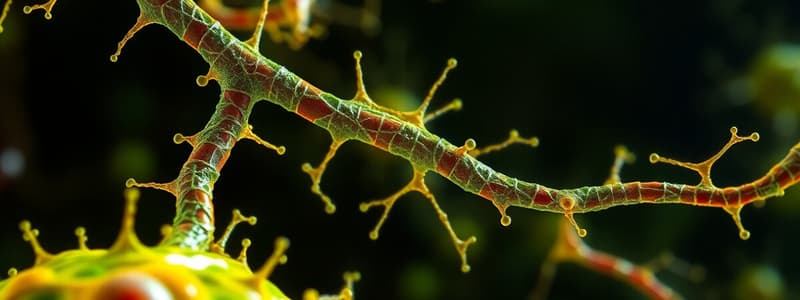Podcast
Questions and Answers
Which type of junction is primarily responsible for preventing leakage of materials between epithelial cells?
Which type of junction is primarily responsible for preventing leakage of materials between epithelial cells?
- Communicating junctions
- Occluding junctions (correct)
- Desmosomes
- Anchor junctions
What is the primary role of cadherins in cell adhesion?
What is the primary role of cadherins in cell adhesion?
- Providing structural support to cells
- Facilitating cell communication
- Mediating cell-cell adhesion (correct)
- Anchoring cells to the extracellular matrix
Which of the following statements about cell junctions is true?
Which of the following statements about cell junctions is true?
- Communicating junctions prevent the flow of ions.
- Cell junctions are primarily found in muscle tissues.
- Desmosomes are a type of anchoring junction. (correct)
- Occluding junctions facilitate cellular signaling.
What characterizes the extracellular matrix?
What characterizes the extracellular matrix?
Which type of junction is associated with communication between adjacent cells?
Which type of junction is associated with communication between adjacent cells?
In vertebrates, cell junctions can be categorized into which of the following types?
In vertebrates, cell junctions can be categorized into which of the following types?
What is a common feature of cell adhesion molecules (CAMs)?
What is a common feature of cell adhesion molecules (CAMs)?
Mutations in which gap junction genes are reported to cause conditions similar to Pelizaeus-Merzbacher disease?
Mutations in which gap junction genes are reported to cause conditions similar to Pelizaeus-Merzbacher disease?
What is the primary function of tight junctions in epithelial cells?
What is the primary function of tight junctions in epithelial cells?
How do adherens junctions contribute to tissue structure?
How do adherens junctions contribute to tissue structure?
Which of the following statements about gap junctions is correct?
Which of the following statements about gap junctions is correct?
What role do cadherins play in adherens junctions?
What role do cadherins play in adherens junctions?
What is the main feature of desmosomes in epithelial tissues?
What is the main feature of desmosomes in epithelial tissues?
What happens to tight junctions if epithelial cells are injured?
What happens to tight junctions if epithelial cells are injured?
Which of the following best describes the structure of gap junctions?
Which of the following best describes the structure of gap junctions?
What is a key role of the basolateral surface of epithelial cells?
What is a key role of the basolateral surface of epithelial cells?
Flashcards
Cell Adhesion Molecules (CAMs)
Cell Adhesion Molecules (CAMs)
Proteins on cell surfaces that facilitate cell-to-cell and cell-to-extracellular matrix interactions, playing a crucial role in cell adhesion, signaling, and migration.
Cell Junctions
Cell Junctions
Specialized structures that connect cells together. They form a physical barrier, regulating movement of molecules and ions between cells.
Extracellular Matrix
Extracellular Matrix
A network of macromolecules that provides structural support and organization to tissues, forming a scaffold around cells.
Types of CAMs: Selectins, Integrins, Immunoglobulins (Ig), Cadherins
Types of CAMs: Selectins, Integrins, Immunoglobulins (Ig), Cadherins
Signup and view all the flashcards
Occluding Junctions (e.g., Tight Junctions)
Occluding Junctions (e.g., Tight Junctions)
Signup and view all the flashcards
Anchoring Junctions (e.g., Adherens Junctions, Desmosomes)
Anchoring Junctions (e.g., Adherens Junctions, Desmosomes)
Signup and view all the flashcards
Communicating Junctions (e.g., Gap Junctions)
Communicating Junctions (e.g., Gap Junctions)
Signup and view all the flashcards
Tight Junctions
Tight Junctions
Signup and view all the flashcards
Adherens Junctions
Adherens Junctions
Signup and view all the flashcards
Gap Junctions
Gap Junctions
Signup and view all the flashcards
Desmosomes
Desmosomes
Signup and view all the flashcards
Functions of Tight Junctions: Protein Separation
Functions of Tight Junctions: Protein Separation
Signup and view all the flashcards
Functions of Tight Junctions: Barrier Function
Functions of Tight Junctions: Barrier Function
Signup and view all the flashcards
Functions of Adherens Junctions
Functions of Adherens Junctions
Signup and view all the flashcards
Functions of Adherens Junctions: Contact Inhibition
Functions of Adherens Junctions: Contact Inhibition
Signup and view all the flashcards
Desmosomes and Cancerous Cells
Desmosomes and Cancerous Cells
Signup and view all the flashcards
Study Notes
Cell-Cell Interaction
- Cell adhesion molecules (CAMs) are proteins on cell surfaces responsible for cell-to-cell and cell-to-extracellular matrix interactions.
- Cell junctions are specialized structures that connect cells together. They form a physical barrier that regulates the movement of molecules and ions between cells.
- Extracellular matrix is a network of macromolecules that provides structural support and organization to tissues.
- Types of CAMs include selectins, integrins, immunoglobulins (Ig), and cadherins.
- Types of cell junctions: occluding junctions (e.g. tight junctions), anchoring junctions (e.g. adherens junctions), communicating junctions (e.g. gap junctions), and desmosomes.
- Importance of cell junctions: They provide a structural framework, regulate transport, and allow communication between cells.
- Tight junctions are found at the apical surface of epithelial cells, forming an impermeable barrier between cells and preventing the movement of fluids.
- Adherens junctions are anchoring junctions that connect cells through cadherin proteins and are linked to the actin cytoskeleton.
- Gap junctions are communicating junctions that allow the direct passage of small molecules and ions between cells, enabling coordinated responses to stimuli.
- Desmosomes are anchoring junctions that provide strong adhesion and connect cells through intermediate filaments.
Tight Junctions
- Functions:
- Prevent the passage of molecules and ions between epithelial cells.
- Prevent the movement of integral membrane proteins between the apical and basolateral surfaces of the cell.
- Examples: Epithelial cells in the human lung.
- Growth stimulant (heregulin) is secreted at the apical surface.
- Receptor (erbB) is located at the basolateral surface.
- The tight junctions prevent self-stimulation of the growth stimulant by maintaining a separation of the proteins.
- Injury to these cells can result in lung disorders (chronic bronchitis) due to unregulated growth stimulant activity.
Adherens Junctions
- Functions:
- Provide mechanical attachment between cells, functioning as anchors.
- They are important in tissues like cardiac muscles and epithelial tissues, allowing them to contract together and maintain structural integrity.
- They also contribute to contact inhibition, regulating cell proliferation and growth.
- Structure:
- Built from cadherins, transmembrane proteins, and catenins, which connect to the actin microfilaments of the cytoskeleton, providing structural reinforcement.
Gap Junctions
- Functions:
- Allow for direct communication between cells through protein channels.
- The channels allow the passage of ions and small molecules < 1000 Daltons, facilitating rapid communication.
- This communication allows for coordinated response to stimuli, such as the coordinated movement of muscles during childbirth.
Desmosomes
- Functions:
- Provide strong points of attachment between cells through protein complexes.
- Necessary in tissues that experience mechanical stress, such as the skin, to provide structural integrity.
- They are connected to the intermediate filaments of the cell cytoskeleton, further strengthening the connections.
- Cancerous cells often lack desmosomes, a characteristic that can lead to loss of cell adhesion and potential metastasis.
Studying That Suits You
Use AI to generate personalized quizzes and flashcards to suit your learning preferences.



